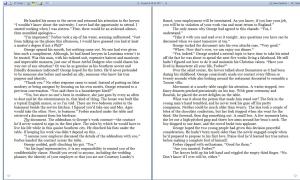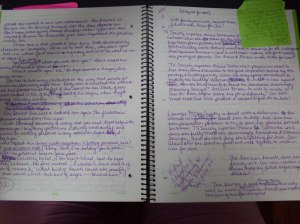NaNo Prep: Draft Writing vs. Regular Writing
One thing that can make a writing marathon like NaNoWriMo discouraging and make writers want to give up is the failure to realize the difference between draft writing and regular writing.
Regular Writing
- In the process of regular writing, you may take the time to re-read what you’ve already written, maybe do a little tweaking or editing on that, before you start writing for the day.
- If you can’t think of the correct word or phrase you want to use, you’ll pause, go to thesaurus.com or some other resource and search until you find just the right term for your prose, then go back to writing.
- You may run across something that needs to be researched. Maybe it’s how to change the oil in a 1957 Ford Mustang. Maybe it’s the correct title for the crew member on the ship who serves the captain’s dinner. So you pause, pull out your reference book or start searching online until you know exactly what you need to know. You incorporate that information, and then you go back to writing.
- A minor character comes on the scene. You think this person may show up again—may even become a secondary character—but you need to know a little more about him. You need to know his name, a bit about his background, what he does, and what role he has in the story. So you pause, go to your Story Bible and start an entry for this character. Then, once you know exactly what you need to know, you go back to writing.
- You get to the end of a piece of dialogue, and you’re not sure exactly how you want to tag it. So you pause and sit back. Do you want to use a “said” or “asked” tag? But those are so passe. Perhaps something with an adverb? No. Adverb tags are of the devil, you heard at a conference once, so better not do that. Maybe an action tag? Okay. Where are the characters in the space and in relation to each other? How would the character move? What’s the facial expression? Maybe you should act it out. Once you have the perfect tag, you get it down in words and continue writing.
Are you getting a picture here of what “regular” writing is?
Draft Writing
- In drafting, you may take the time to re-read the last few paragraphs of what you wrote the day before to remind yourself where you left off, but you don’t make any changes and you immediately start writing as soon as you finish reading.
- If you can’t think of the correct word or phrase you want to use, you type ____________ and then may even use the comments feature to highlight it and type a reminder to yourself to look it up later and then resume writing.
- You may run across something that needs to be researched. Maybe it’s how to change the oil in a 1957 Ford Mustang. Maybe it’s the correct title for the crew member on the ship who serves the captain’s dinner. So you type ___________ and use the comments feature to highlight it and type a reminder to yourself to look it up later and then resume writing.
- A minor character comes on the scene. You think this person may show up again—may even become a secondary character—but you need to know a little more about him. You need to know his name, a bit about his background, what he does, and what role he has in the story. So you type ___________ and then may even use the comments feature to highlight it and type a reminder to yourself to make it up later and resume writing.
- You get to the end of a piece of dialogue, and you’re not sure exactly how you want to tag it. So you write “he said” or “she asked” and then type ___________ and use the comments feature to highlight it and type a reminder to yourself to write something better later and then resume writing.
Are you catching the difference between regular writing and drafting?
In drafting, the most important thing to do is get the bones of the story down in writing. It doesn’t have to be perfect. It doesn’t even have to be good. That’s what the second, third, fifth, tenth draft process is for.
Forget about “getting it right.” Just get it written!
Trackbacks
- #FirstDraft 60 Day 13: A Draft-Writing Assignment #amwriting #nanoprep #nanowrimo | KayeDacus.com
- #FirstDraft120 DAY 120: WE MADE IT THROUGH!!!! (Timer Tuesday) | #amwriting #1k1hr #2017goals | KayeDacus.com
- 2017 Writing Challenge–What’s Your Writing Goal for 2017? | KayeDacus.com
- #FirstDraft90: Days 1-30 Prep Work Schedule | KayeDacus.com
Comments are closed.



Most excellent advice. I was a Municipal Liaison for NaNo in 2011 and we used to call it the Zero Draft to get people to care a little less about the whys and wherefores and get to that all-important word count!
LikeLike
Reblogged this on TamBorgia's NaNoWriMo and commented:
More thoughts for your pre-planning.
LikeLike
I’ve used [brackets] and put the comments in there. They can be searched for easily later.
When you use the comment feature do those words show up in your word count? The stuff in my brackets does, but I use it pretty sparingly and it is close to the number of words (or few) then I will use eventually so I’ve left them in. Is that cheating?
I’ve finished some NaNo years and not finished others. I kind of split the difference between “Regular” writing and “Draft” writing. I think it is okay to do that too.
What if you give yourself a 2 minute time limit? If you decide, find or remember something in 2 minutes THEN put a placeholder and comment in. If you find you can still make your daily word count then it should be okay, right?
LikeLike
When you use the comments feature, it shows up in a bubble out to the right, and you can use the Review tab to jump from comment to comment without having to scroll through the document. And the comments don’t add into the wordcount.
LikeLike
Great post, Kaye!
LikeLike